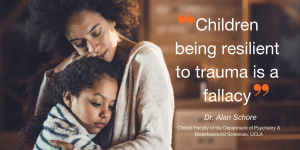
What is trauma?
This article was authored by Lauren Thomas,
Program Manager, Professional Community Engagement
at the Australian Childhood Foundation.
Depending on who or what you read, trauma will be defined in a variety of ways. Is it simple or complex? Developmental, relational or attachment oriented? Within the field of childhood trauma, we have a multitude of definitions and sub categories that can be quite confusing for practitioners.
Even in our own materials, we have noticed a shift in the way the Foundation describes trauma of late and I’m guessing this is due to the ever evolving nature of our field. But I am still left with the sense that it is important that we all know what we are on about. So… I thought this might be a good spot to have a conversation around what we mean when we use the word ‘trauma’ and how it is connected to ‘stress’
Stress
Stress is something that challenges your capacity to cope. If we all think back to psychology class at school we might remember learning about the stress bell curve, and the knowledge that some stress can be good for us, too much can be bad.
Your ‘capacity to cope’ is interesting too… each individual will have a differing capacity to cope. Your own capacity might be influenced by your family of origin, genetics and epigenetics, training, experience, support networks and much more.
Trauma
Trauma is the emotional, psychological and physiological residue left over from heightened stress that accompanies experiences of threat, violence, and life-challenging events.
Traumatic experiences overwhelm your capacity to cope. That same capacity is influenced by hundreds of personal variables. This helps us to understand some of the differences in the way individuals respond to similar levels of trauma or similar traumatising events in different ways.

This is not the same as resilience. Since trauma is overwhelming by its nature, we cannot be resilient to it. If our brain and our body are overwhelmed, a host of subconscious responses are enacted as a direct consequence of that overwhelm. It is more accurate to describe how individuals adapt in a protective way to the impact of trauma in their lives.
In ‘Making Space for Learning’ (found here) we described how experiences of elevated, prolonged stress or trauma rock the very core of children and young people. In these circumstances, children are overwhelmed with the internal reactions that race through their brains and bodies. They do anything to survive, not because they want to but because they need to. They shut down their feelings. They push away memories of pain. They stop relying on relationships around them to protect them. They stop trusting and believing in others.
Even after the stressful or traumatic situation has passed, children’s brains and bodies continue to react as if the stress is continuing. They become self-protective. They spend a lot of their energy scanning their environment for threat. Their bodies act as if they are in a constant state of alarm. Their brains are endlessly vigilant.
Simple trauma
Simple trauma is overwhelming and painful – and quite often not simple! It involves experiences of events that are life threatening and/or have the potential to cause serious injury. However, these incidents are not complicated by being found in relationships core to survival, by being likely to be associated with stigma, or being experienced repetitively over time. They are often single incidents. There are also generally supportive and helpful community responses to the people who have experienced the trauma.
Simple trauma includes the experience of being in car accidents, house fires, bushfires, earthquakes, and cyclones.
Complex trauma
Complex trauma involves interpersonal threat, violence, and violation. In contrast to ‘simple trauma,’ it generally includes multiple incidents and is, therefore, longer in duration. It is almost always associated with stigma and a sense of shame experienced by its victims.
Complex trauma can be further complicated when it is experienced in relationships. When those we look to and rely on for our survival are also those who threaten and violate, victims are likely to have further impacts.
As a community we can also complicate victim’s trauma through offering responses that are not helpful, further blaming and disempowering the targets of the violence. Individuals who experience complex trauma often feel disconnected from the support of others.
Examples of complex trauma include experiences of child abuse, bullying, domestic violence, rape, war, and imprisonment.
Developmental trauma
Trauma – especially complex relational trauma – experienced during a time of development can have significant impacts. Since children and young people are very vulnerable to the effects of trauma because of their brain’s developmental immaturity.
Because children rely so much on the adults around them, they are even more intensely affected when it is these adults who cause harm to them. The trauma associated with experiences of interpersonal violence undermines the very resource that can help children recover – the stability and predictability of their connections with others.
When we use the phrase ‘Developmental trauma’ we are including children who are neglected, abused, forced to live with family violence or experience high parental conflict in the context of separation or divorce.
